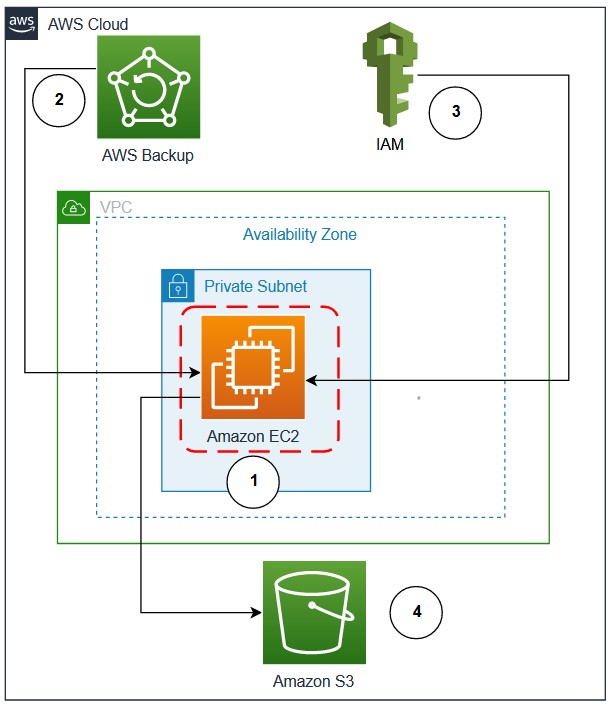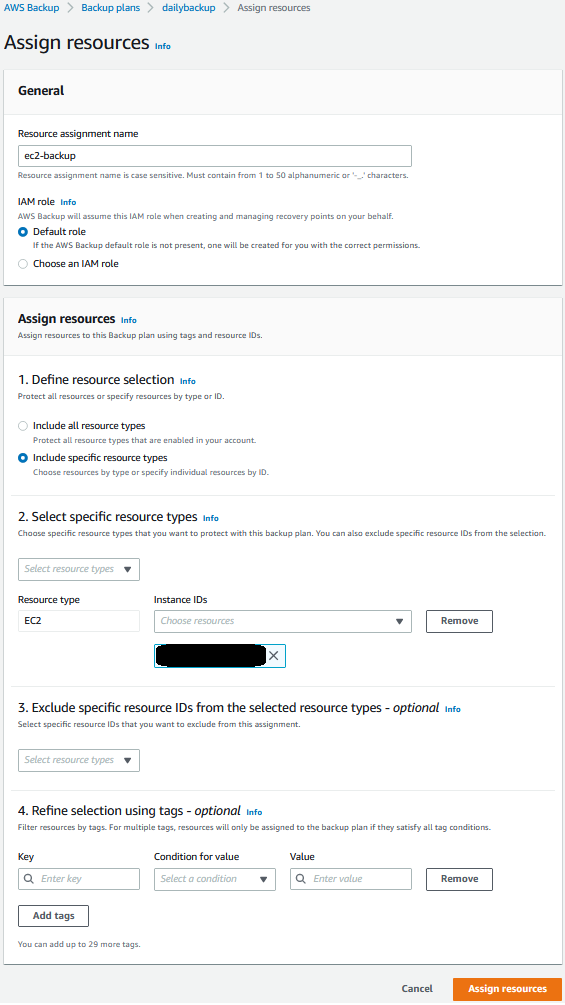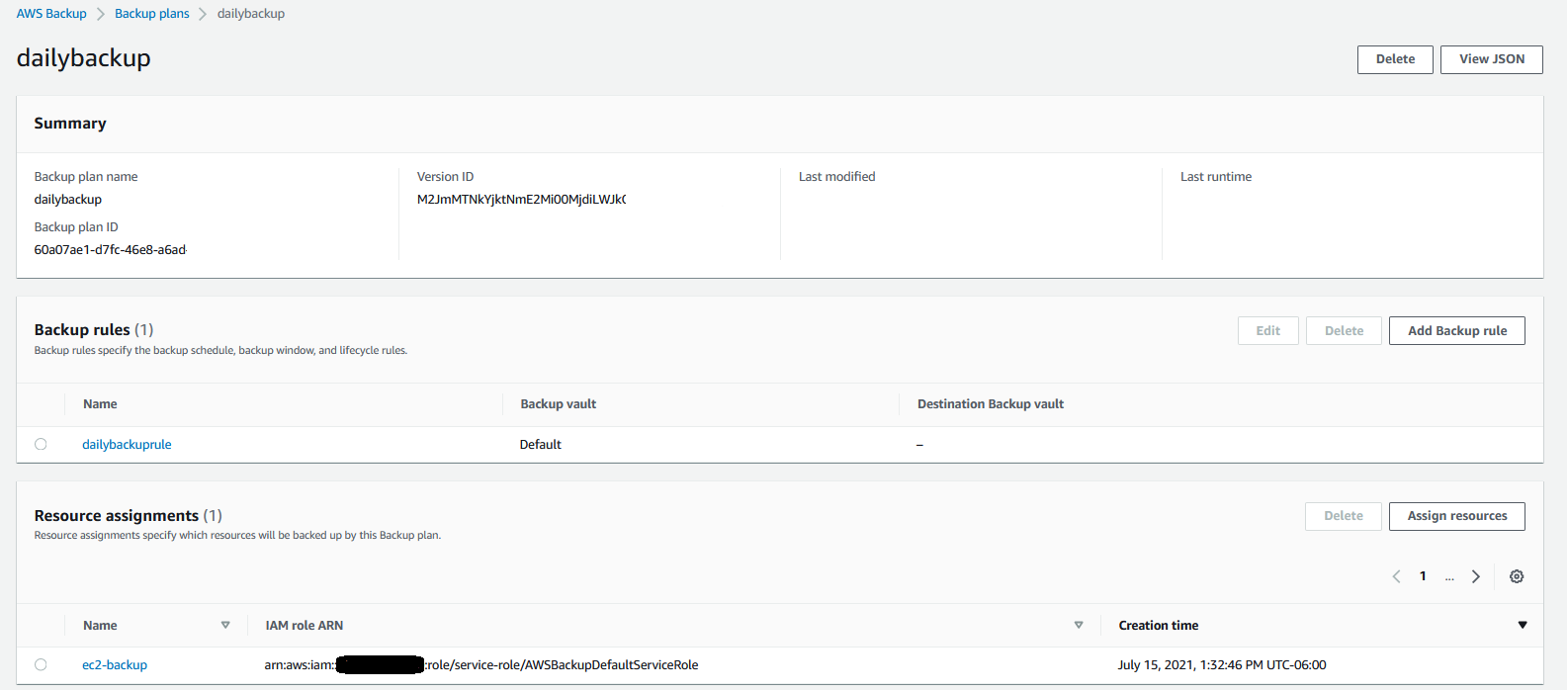AWS Architecture Blog
Using AWS Backup and Oracle RMAN for backup/restore of Oracle databases on Amazon EC2: Part 1
Customers running Oracle databases on Amazon Elastic Compute Cloud (Amazon EC2) often take database and schema backups using Oracle native tools, like Data Pump and Recovery Manager (RMAN), to satisfy data protection, disaster recovery (DR), and compliance requirements. A priority is to reduce backup time as the data grows exponentially and recover sooner in case of failure/disaster.
In situations where RMAN backup is used as a DR solution, using AWS Backup to backup the file system and using RMAN to backup the archive logs are an efficient method to perform Oracle database point-in-time recovery in the event of a disaster.
Sample use cases:
- Quickly build a copy of production database to test bug fixes or for a tuning exercise.
- Recover from a user error that removes data or corrupts existing data.
- A complete database recovery after a media failure.
There are two options to backup the archive logs using RMAN:
- Using Oracle Secure Backup (OSB) and an Amazon Simple Storage Service (Amazon S3) bucket as the storage for archive logs
- Using Amazon Elastic File System (Amazon EFS) as the storage for archive logs
This is Part 1 of this two-part series, we provide a mechanism to use AWS Backup to create a full backup of the EC2 instance, including the OS image, Oracle binaries, logs, and data files. In this post, we will use Oracle RMAN to perform archived redo log backup to an Amazon S3 bucket. Then, we demonstrate the steps to restore a database to a specific point-in-time using AWS Backup and Oracle RMAN.
Solution overview
Figure 1 demonstrates the workflow:
- Oracle database on Amazon EC2 configured with Oracle Secure Backup (OSB)
- AWS Backup service to backup EC2 instance at regular intervals.
- AWS Identity and Access Management (IAM) role for EC2 instance that grants permission to write archive log backups to Amazon S3
- S3 bucket for storing Oracle RMAN archive log backups

Figure 1. Oracle Database in Amazon EC2 using AWS Backup and S3 for backup and restore
Prerequisites
For this solution, the following prerequisites are required:
- An AWS account
- Oracle database and AWS CLI in an EC2 instance
- Access to configure AWS Backup
- Acces to S3 bucket to store the RMAN archive log backup
1. Configure AWS Backup
You can choose AWS Backup to schedule daily backups of the EC2 instance. AWS Backup efficiently stores your periodic backups using backup plans. Only the first EBS snapshot performs a full copy from Amazon Elastic Block Storage (Amazon EBS) to Amazon S3. All subsequent snapshots are incremental snapshots, copying just the changed blocks from Amazon EBS to Amazon S3, thus, reducing backup duration and storage costs. Oracle supports Storage Snapshot Optimization, which takes third-party snapshots of the database without placing the database in backup mode. By default, AWS Backup now creates crash-consistent backups of Amazon EBS volumes that are attached to an EC2 instance. Customers no longer have to stop their instance or coordinate between multiple Amazon EBS volumes attached to the same EC2 instance to ensure crash-consistency of their application state.
You can create daily scheduled backup of EC2 instances. Figures 2, 3, and 4 are sample screenshots of the backup plan, associating an EC2 instance with the backup plan.

Figure 2. Configure backup rule using AWS Backup

Figure 3. Select EC2 instance containing Oracle Database for backup

Figure 4. Summary screen showing the backup rule and resources managed by AWS Backup
Oracle RMAN archive log backup
While AWS Backup is now creating a daily backup of the EC2 instance, we also want to make sure we backup the archived log files to a protected location. This will let us do point-in-time restores and restore to other recent times than just the last daily EC2 backup. Here, we provide the steps to backup archive log using RMAN to S3 bucket.
Backup/restore archive logs to/from Amazon S3 using OSB
Backing-up the Oracle archive logs is an important part of the process. In this section, we will describe how you can backup their Oracle Archive logs to Amazon S3 using OSB. Note: OSB is a separately licensed product from Oracle Corporation, so you will need to be properly licensed for OSB if you use this approach.
2. Setup S3 bucket and IAM role
Oracle Archive log backups can be scheduled using cron script to run at regular interval (for example, every 15 minutes). These backups are stored in an S3 bucket.
a. Create an S3 bucket with lifecycle policy to transition the objects to S3 Standard-Infrequent Access.
b. Attach the following policy to the IAM Role of EC2 containing Oracle database or create an IAM role (ec2access) with the following policy and attach it to the EC2 instance. Update bucket-name with the bucket created in previous step.
{ "Sid": "S3BucketAccess", "Effect": "Allow", "Action": [ "s3:PutObject", "s3:GetObjectAcl", "s3:GetObject", "s3:ListBucket", "s3:DeleteObject" ], "Resource": [ "arn:aws:s3:::bucket-name", "arn:aws:s3:::bucket-name/*" ] }
3. Setup OSB
After we have configured the backup of EC2 instance using AWS Backup, we setup OSB in the EC2 instance. In these steps, we show the mechanism to configure OSB.
a. Verify hardware and software prerequisites for OSB Cloud Module.
b. Login to the EC2 instance with User ID owning the Oracle Binaries.
c. Download Amazon S3 backup installer file (osbws_install.zip)
d. Create Oracle wallet directory.
mkdir $ORACLE_HOME/dbs/osbws_wallete. Create a file (osbws.sh) in the EC2 instance with the following commands. Update IAM role with the one created/updated in Step 2b.
java -jar osbws_install.jar —IAMRole ec2access walletDir $ORACLE_HOME/dbs/osbws_wallet -libDir $ORACLE_HOME/lib/f. Change permission and run the file.
chmod 700 osbws.sh
./osbws.sh
Sample output: AWS credentials are valid.
Oracle Secure Backup Web Service wallet created in directory /u01/app/oracle/product/19.3.0.0/db_1/dbs/osbws_wallet.
Oracle Secure Backup Web Service initialization file /u01/app/oracle/product/19.3.0.0/db_1/dbs/osbwsoratst.ora created.
Downloading Oracle Secure Backup Web Service Software Library from file osbws_linux64.zip.
Download complete.g. Set ORACLE_SID by executing below command:
. oraenv
h. Running the script – osbws.sh installs OSB libraries and creates a file called osbws<ORACLE_SID>.ora.
i. Add/modify below with S3 bucket(bucket-name) and region(ex:us-west-2) created in Step 2a.
OSB_WS_HOST=http://s3.us-west-2.amazonaws.com
OSB_WS_BUCKET=bucket-name
OSB_WS_LOCATION=us-west-24. Configure RMAN backup to S3 bucket
With OSB installed in the EC2 instance, you can backup Oracle archive logs to S3 bucket. These backups can be used to perform database point-in-time recovery in case of database crash/corruption . oratst is used as an example in below commands.
a. Configure RMAN repository. Example below uses Oracle 19c and Oracle Sid – oratst.
RMAN> configure channel device type sbt parms='SBT_LIBRARY=/u01/app/oracle/product/19.3.0.0/db_1/lib/libosbws.so,SBT_PARMS=(OSB_WS_PFILE=/u01/app/oracle/product/19.3.0.0/db_1/dbs/osbwsoratst.ora)';b. Create a script (for example, rman_archive.sh) with below commands, and schedule using crontab (example entry: */5 * * * * rman_archive.sh) to run every 5 minutes. This will makes sure Oracle Archive logs are backed up to Amazon S3 frequently, thus ensuring an recovery point objective (RPO) of 5 minutes.
dt=`date +%Y%m%d_%H%M%S`
rman target / log=rman_arch_bkup_oratst_${dt}.log <<EOF
RUN
{
allocate channel c1_s3 device type sbt
parms='SBT_LIBRARY=/u01/app/oracle/product/19.3.0.0/db_1/lib/libosbws.so,SBT_PARMS=(OSB_WS_PFILE=/u01/app/oracle/product/19.3.0.0/db_1/dbs/osbwsoratst.ora)' MAXPIECESIZE 10G;
BACKUP ARCHIVELOG ALL delete all input;
Backup CURRENT CONTROLFILE;
release channel c1_s3;
}
EOFc. Copy RMAN logs to S3 bucket. These logs contain the database identifier (DBID) that is required when we have to restore the database using Oracle RMAN.
aws s3 cp rman_arch_bkup_oratst_${dt}.log s3://bucket-name5. Perform database point-in-time recovery
In the event of a database crash/corruption, we can use AWS Backup service and Oracle RMAN Archive log backup to recover database to a specific point-in-time.
a. Typically, you would pick the most recent recovery point completed before the time you wish to recover. Using AWS Backup, identify the recovery point ID to restore by following the steps on restoring an Amazon EC2 instance. Note: when following the steps, be sure to set the “User data” settings as described in the next bullet item.
After the EBS volumes are created from the snapshot, there is no need to wait for all of the data to transfer from Amazon S3 to your EBS volume before your attached instance can start accessing the volume. Amazon EBS snapshots implement lazy loading, so that you can begin using them right away.
b. Be sure the database does not start automatically after restoring the EC2 instance, by renaming /etc/oratab. Use the following command in “User data” section while restoring EC2 instance. After database recovery, we can rename it back to /etc/oratab.
#!/usr/bin/sh
sudo su -
mv /etc/oratab /etc/oratab_bkc. Login to the EC2 instance once it is up, and execute the RMAN recovery commands mentioned. Identify the DBID from RMAN logs saved in the S3 bucket. These commands use database oratst as an example:
rman target /
RMAN> startup nomount
RMAN> set dbid DBID
# Below command is to restore the controlfile from autobackup
RMAN> RUN
{
allocate channel c1_s3 device type sbt
parms='SBT_LIBRARY=/u01/app/oracle/product/19.3.0.0/db_1/lib/libosbws.so,SBT_PARMS=(OSB_WS_PFILE=/u01/app/oracle/product/19.3.0.0/db_1/dbs/osbwsoratst.ora)';
RESTORE CONTROLFILE FROM AUTOBACKUP;
alter database mount;
release channel c1_s3;
}
#Identify the recovery point (sequence_number) by listing the backups available in catalog.
RMAN> list backup;In Figure 5, the most recent archive log backed up is 380, so you can use this sequence number in the next set of RMAN commands.

Figure 5. Sample output of Oracle RMAN “list backup” command
RMAN> RUN
{
allocate channel c1_s3 device type sbt
parms='SBT_LIBRARY=/u01/app/oracle/product/19.3.0.0/db_1/lib/libosbws.so,SBT_PARMS=(OSB_WS_PFILE=/u01/app/oracle/product/19.3.0.0/db_1/dbs/osbwsoratst.ora)';
recover database until sequence sequence_number;
ALTER DATABASE OPEN RESETLOGS;
release channel c1_s3;
}d. To avoid performance issues due to lazy loading, after the database is open, run the following command to force a faster restoration of the blocks from S3 bucket to EBS volumes (this example allocates two channels and validates the entire database).
RMAN> RUN
{
ALLOCATE CHANNEL c1 DEVICE TYPE DISK;
ALLOCATE CHANNEL c2 DEVICE TYPE DISK;
VALIDATE database section size 1200M;
}e. This completes the recovery of database, and we can let the database automatically start by renaming file back to /etc/oratab.
mv /etc/oratab_bk /etc/oratab6. Backup retention
Ensure that the AWS Backup lifecycle policy matches the Oracle Archive log backup retention. Also, follow documentation to configure Oracle backup retention and delete expired backups. This is a sample command for Oracle backup retention:
CONFIGURE BACKUP OPTIMIZATION ON;
CONFIGURE RETENTION POLICY TO RECOVERY WINDOW OF 31 DAYS;
RMAN> RUN
{
allocate channel c1_s3 device type sbt
parms='SBT_LIBRARY=/u01/app/oracle/product/19.3.0.0/db_1/lib/libosbws.so,SBT_PARMS=(OSB_WS_PFILE=/u01/app/oracle/product/19.3.0.0/db_1/dbs/osbwsoratst.ora)';
crosscheck backup;
delete noprompt obsolete;
delete noprompt expired backup;
release channel c1_s3;
}Cleanup
Follow below instructions to remove or cleanup the setup:
- Delete the backup plan created in Step 1.
- Uninstall Oracle Secure Backup from the EC2 instance.
- Delete/Update IAM role (
ec2access) to remove access from the S3 bucket used to store archive logs. - Remove the cron entry from the EC2 instance configured in Step 4b.
- Delete the S3 bucket that was created in Step 2a to store Oracle RMAN archive log backups.
Conclusion
In this post, we demonstrate how to use AWS Backup and Oracle RMAN Archive log backup of Oracle databases running on Amazon EC2 can restore and recover efficiently to a point-in-time, without requiring an extra-step of restoring data files. Data files are restored as part of the AWS Backup EC2 instance restoration. You can leverage this solution to facilitate restoring copies of your production database for development or testing purposes, plus recover from a user error that removes data or corrupts existing data.
To learn more about AWS Backup, refer to the AWS Backup AWS Backup Documentation.